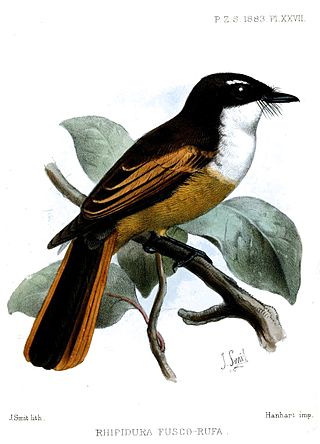
Fantails are small insectivorous songbirds of the genus Rhipidura in the family Rhipiduridae, native to Australasia, Southeast Asia and the Indian subcontinent. Most of the species are about 15 to 18 cm long, specialist aerial feeders, and named as "fantails", but the Australian willie wagtail is a little larger, and, though still an expert hunter of insects on the wing, concentrates equally on terrestrial prey.

Eupithecia is the largest genus of moths of the family Geometridae, and the namesake and type genus of tribe Eupitheciini. Species in the genus are, like those of other genera in the tribe, commonly known as pugs. The genus is highly speciose, with over 1400 species, and members of the genus are present in most of the world with exception of Australasia. Roughly a quarter of described Eupithecia species occur in the Neotropical realm, where they have an especially high species diversity in the montane rain forests of the Andes. The genus includes a few agricultural pest species, such as the currant pug moth, Eupithecia assimilata, which is a pest on hops, and the cloaked pug moth, Eupithecia abietaria, which is a cone pest in spruce seed orchards.

The cinnamon-tailed fantail is a fantail restricted to the Banda Sea Islands of Indonesia.

Synallaxis is a genus of birds in the ovenbird family, Furnariidae. It is one of the most diverse genera in the family and is composed of small birds that inhabit dense undergrowth across tropical and subtropical habitats in the Neotropical region. Some species show contrasting plumage patterns involving rufous crown and wing patches and black throat patches but they are difficult to see as they keep ensconced in vegetation most of the time. Most species show the long graduated tail with pointy feathers that is typical of spinetails. They are also characterized by constructing large domed nests with stick, including a long entrance tube. Some species can be difficult to distinguish from one another on the basis of their plumage, but can be tell apart by their vocalizations, which can be quite distinctive.

The rusty-headed spinetail is a species of bird in the family Furnariidae. It is endemic to the Sierra Nevada de Santa Marta.

Arthonia is a genus of lichens in the family Arthoniaceae. It was circumscribed by Swedish botanist Erik Acharius in 1806.
In August 2018, the IUCN Red List of Threatened Species identified 6086 Vulnerable species, subspecies and varieties, stocks and sub-populations in the Animalia kingdom.
On 29 January 2010, the IUCN Red List of Threatened Species identified 2657 near threatened species, subspecies, stocks and sub-populations in the Animalia kingdom.
Eupithecia fuscorufa is a moth in the family Geometridae. It is found in Pakistan.

Desmiphorini is a tribe of longhorn beetles of the subfamily Lamiinae.
Falsoterinaea is a genus of longhorn beetles of the subfamily Lamiinae, containing the following species:
Falsoterinaea pakistana is a species of beetle in the family Cerambycidae. It was described by Stephan von Breuning in 1975.






